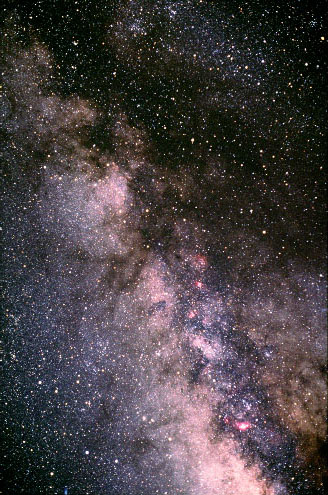Aquila, Scutum, Ophiuchus, Serpens Cauda and Serpens Caput
Aquila can be found by using the “Summer Triangle” (the three bright stars Altair, Deneb, and Vega) as a signpost. The first magnitude star Altair at the apex of the Summer Triangle, leads the constellation of Aquila, held since ancient times to represent an Eagle. Just below Aquila is the tiny constellation of Scutum and to the west is Ophiuchus, known as the serpent bearer, although he seems to have succeeded in dividing the poor creature he is carrying into two pieces! Serpens is nowadays normally thought of as two separate constellations, Serpens Caput (the head) and Serpens Cauda (the tail).
Aquila and the Milky way
Despite being a fairly conspicuous grouping, on the Summer Milky Way, Aquila is curiously devoid of interesting objects for amateur telescopes. By way of contrast, inconspicuous Scutum contains one of the finest open clusters from Messier’s catalogue. This is M11, otherwise known as the “Wild Duck” cluster because of the “V” formation formed by some of its brighter stars. Another famous open cluster lies over the border in Serpens Cauda. This is M16, the “Star Queen” or “Eagle” cluster made famous by the spectacular Hubble image: “Pillars of Creation”.
The open or galactic clusters are comparatively young objects in cosmic terms, since the stars belonging to them are usually dispersed by gravitational interaction with the rest of the galaxy within a few hundred million years. At the other extreme are the globular clusters, which are closed systems lying outside the rest of the galaxy. These objects are at least as old as the galaxy itself, over 10 billion years. Ophiuchus contains more globular clusters from Messier’s catalogue than any other constellation, but the finest example of this type of object in this part of the sky is M5 in Serpens Caput.
There are many other interesting objects to be found in these constellations. An excellent double star for example is 70 Ophiuchi. This area also marks the northern edge of the galactic centre and
Ophiuchus and Scutum in particular contain some wonderful star clouds and dark nebulae. One very faint object in Ophiuchus that is worth tracking down is 9th magnitude Barnard’s Star. At six light years this is the closest star to us after our own Sun and the Alpha Centauri system, and has a larger proper motion than any other star. Even Barnard’s star however takes a human lifetime to crawl across the field of a high power eyepiece!
POWERPOINT SLIDE SHOW (700KB)